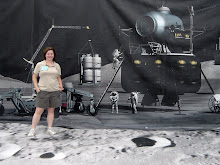While Spirit is stuck in one place for a while, looking at the sky and dirt, I've been paying a lot more attention to Opportunity. Over at Meridiani Planum, we're headed toward this huge (by rover standards) hole in the ground, Victoria crater. Craters over here are named after great ships of exploration, and Victoria was the only ship to successfully return from Magellan's voyage around the world. Victoria crater is just about the size of Meteor Crater here in the southwest, a little less than 1 km wide. Check out the rim of Victoria crater as Opportunity approaches.
Victoria punched a deeper hole into the Meridiani Planum surface than the last big crater Opportunity visited, Endurance crater. Endurance crater was where we got to check out Burns Cliff, a fantastically well-preserved set of sedimentary layers in the inside crater wall that showed crossbedding, evaporite mineral casts, and the little hematite blueberries. Craters are nature's roadcuts, the way these little mechanical geologists will be able to check out what's underneath the surface of the plains, and we're all hoping that the inside walls of Victoria show us more wonders.
Right now, Opportunity is about to roll up onto Victoria's ejecta blanket, which is the apron of material that was thrown out of the crater and rained down around it. When craters form, a lot of stuff gets thrown out from a depth roughly as much as the drater diameter. As the rocks deform and fail with the crater shock, the final crater is much shallower, only about a tenth as deep as the diameter. So, the rocks in the ejecta blanket come from much deeper down than the rocks at the bottom of the crater now. If you want to look for the deepest rocks, you look at the edges of the ejecta, which is what's next on our journey. We're stopping nearly every weekend to check out our surroundings to see if anything is different yet.
It's a little ironic - we're now interested in changes in the rocks but all we see are really large expanses of the same Meridiani Planum bedrock. One of the science team members remarked that last year, huge expanses of crossbedded bedrock would have been nirvana for this rover. But the scientists were so good at eking out the geologic history from what small outcrops they had that now we are just enjoying this area for the ease of driving over lots of flat material.
Subscribe to:
Post Comments (Atom)

No comments:
Post a Comment